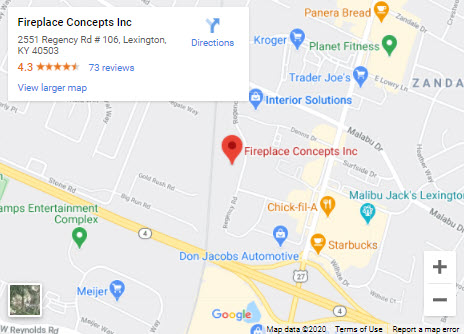
Why Does My Gas Fireplace Keep Going Out?
Why does my gas fireplace keep going out? This is a common question that homeowners ask when they experience this issue. It is one of the most common problems with gas fireplaces and is usually linked to the ignition assembly components. If your fireplace refuses to stay lit, there is likely a problem with one or more of the components that make up the ignition assembly. The main components referred to here are the pilot tubing and the pilot light assembly as well as the thermopile and the thermocouple. If you run into this problem, call our experienced fireplace service technicians. Our team at Fireplace Concepts can help you with your fireplace, today!
Basic Components of a Gas Fireplace
To understand the answer to the question of why does my gas fireplace keep going out, it is helpful to have some knowledge about the basic components that make up a gas fireplace. Four primary components are of interest here. They include:
Pilot Light – The majority of gas fireplaces utilize a pilot light that produces a low flame at all times. This includes when the fireplace is not currently being used. This pilot light functions as the fireplace’s ignition source for the gas.
Thermocouple – A gas fireplace’s thermocouple is responsible for monitoring its temperature.
Thermopile – The next component to look at is the thermopile. This component regulates the flow of gas that is delivered to the fireplace.
Oxypilot – The oxypilot is a key safety feature of gas fireplaces. It is designed to protect you and your family from exposure to carbon monoxide. If insufficient oxygen is present the oxypilot will stop gas flow to the fireplace.
What Parts Should You Check If Your Fireplace Keeps Going Out?
The first thing that you should check if you are experiencing issues with a fireplace that keeps going out is the pilot light. It is one of the most common causes of this issue and one of the easiest ones to resolve. If the pilot light is not lit, then this is likely going to be the root cause of the problem.
Most gas fireplace pilot lights are operated by either a key or a control panel. Either of these is generally positioned behind the logs and on the fireplace’s inside wall.
Checking the Pilot Light If the Fireplace Has a Control Panel
- Turn the knob to the off position and wait for 5 minutes so that the gas can clear
- Turn the shutoff valve so that it is parallel with the gas line
- Move the knob to the position marked pilot when you are ready to light it
- Hold the knob for at least 30 seconds so that the thermocouple can heat up and register that there is an active pilot
- Switch the knob to on (This should keep the pilot light lit)
Checking the Pilot Light If the Fireplace Has a Key
- Insert the key into the knob of the gas valve
- Use a long lighter to ignite the burner
- Use the key to turn the gas valve counterclockwise (One-half turn)
- At this point, the gas should be released and the pilot should light up
How the Thermocouple Works
The thermocouple of your gas fireplace is a variety of thermometer. It is composed of a pair of wires made from different metals. These are joined at both ends. One of the junctions stays at the temperature to be measured while the other one is held at a lower, fixed temperature.
The current that is generated by way of the circuit is in proportion to the difference in temperature. It is this difference that the thermocouple works off of. This is what makes it possible for it to allow gas from the valve to pass to the main burners. This only occurs when the thermocouple’s tip stays in constant contact with the pilot light’s flame.
How the Oxypilot Works
Your gas fireplace’s oxypilot is an atmospheric sensor. Its purpose is to put out a gas fire if there is not enough oxygen currently present in the room. This crucial device is one of the key safety mechanisms of your gas fireplace. Its job is to keep you and your family safe from the dangers of carbon monoxide poisoning in the case that the air present in the room becomes vitiated.
Whenever the oxygen percentage available in a room drops, the shape of the flame is changed. At this point, the heat is removed from the thermocouple. This leads to the gas valve shutting off. If your gas fireplace’s oxypilot becomes blocked by soot or dust, the flame will end up lifting away from the thermocouple/flame sensing electrode. When this occurs, the pilot light will refuse to light or the fire will cut out.
When Should You Call a Professional?
Problems with a gas fireplace continuing to go out are often the result of sensors that are faulty or dirty. In many cases, cleaning the pilot light, oxypilot, thermopile, or thermocouple can resolve the issue. It is often the case that these crucial parts do need to be replaced. It is important to remember that gas is a hazardous substance to work with. It is often your best move to bring in the services of trained professionals if you continue to deal with issues related to your gas fireplace going out. You should never attempt to undertake any maintenance on your gas fireplace if you are not 100% confident in what you are doing. When in doubt, bring in a professional to do the job for you.
If the pilot light on your gas fireplace will not stay lit and you continue to have issues with your fire going out, our team here at Fireplace Concepts is ready to be of assistance. We are the fireplace pros that homeowners here in the Lexington, KY region rely on for all of their gas fireplace repair, maintenance, and installation needs. Contact us today through our online contact form or by giving us a call. We are ready to provide you with a quick response so that you can get your gas fireplace back on track and working its best.

